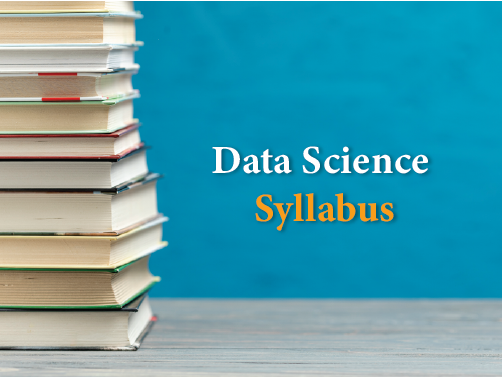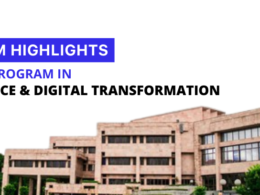For every aspiring Data Scientist, the most important question is about Data Science syllabus. In this article, we will discuss the syllabus for Data Science.
Learning Data Science without a structure, syllabus or course can be an uphill task. To stare into an endless space full of unintelligible data and make sense out of it is not possible for everybody.
What is the syllabus for Data Science?
Data Science syllabus consists of a considerable portion of math, statistics, coding, domain expertise, Machine Learning algorithms and Data Analysis.
Given that there are so many different fields to explore while learning Data Science, you can literally start anywhere!
However, we suggest to start with brushing up your math and statistics. Most of your math and stats knowledge will pick up from where you left it in school.
Let’s see the different aspects of Data Science separately:
1. Mathematical & Statistical Skills
The syllabus for Data Science involves a lot of Probability and Linear Algebra.
To go in deeper, you will need to develop skills for conditional probability. A lot of Machine Learning algorithms depend on the concept of Conditional Probability.
You can check our article on Top Machine Learning Algorithms here.
While Naive Bayes Classification deals with Conditional Probability, algorithms like Linear and Logistic Regression covers both probability and the concept of exponents from Algebra.
Machine Learning algorithms are not just why you need sound mathematical skills for completing your Data Science syllabus. The concept of Neural Networks would be totally lost on you if you don’t understand Linear Algebra.
Neural Networks are applications of Deep Learning designed emulating the structure of human neural networks. Neural Networks are the science behind Machines Learning on their own and improving processes accordingly.
The study of Neural Networks involves Matrices. Neural Networks use Linear Equations represented through a matrix/ matrices. A Matrix is a rectangular representation of numbers, characters or expressions in rows and columns.
This is not the entire extent of mathematical knowledge that you’ll need for completing your Data Science Syllabus. You also need to know Euclidean distance for K-means, Entropy for Decision trees and other Machine Learning algorithms.
2. Coding
The second part of Data Science syllabus deals with coding.
This is the part people with non-coding backgrounds are most uncomfortable with.
While Data Science does not require a lot of coding, you need to have more than a basic working knowledge of coding to make a breakthrough in the field.
You can learn to code in any language really but there are more suited languages to Machine Learning than others. R and Python are the more competitive players in this race. R and Python have many simplistic packages to offer people which makes a lot of coding redundant.
Both tools are open-source, free to learn and supported by the largest communities online. While R is used majorly for statistical analysis and academic research, Python is the more user-friendly tool designed for the comfort of its users.
TIOBE Index ranked Python as the language of the year in 2019.

Python was largely developed by its users, who like you, are Data Science aspirants and understand how time-consuming coding can be. So, a programming language as easy to read as simple English with a lot of functionality already taken care of, comes a long way in helping newbie Data Scientists.
If you want to know more about Python, here is an article to help you out.
3. Domain Expertise
The syllabus for Data Science revolves not just around theory.
Having practical exposure is just as necessary to become a successful Data Scientist. Domain expertise translates to developing expertise in your area of work. As a Data Scientist, whatever field or line of business you’re in, you will need to develop business acumen to solve problems or issues faced therein.
In simple words, you cannot improve or build upon a process you don’t understand. That is why experienced Data Scientists are more productive and innovative as compared to freshers in the field.
You must have heard, the first step to solving a problem is recognizing there is one. Even in a healthy and profitable business, there can be many such areas of improvement that need to be identified and taken care of.
You can definitely read business books to develop a specific mindset but the literature will only help you augment what you already know. In case, you do not have any major knowledge as to how a business or functional area is run, books can only help you so much.
4. Machine Learning algorithms
Machine Learning algorithms can be the more time-taking of the rest of Data Science syllabus to master.
Learning ML algorithms is a more difficult feat to accomplish than any other points mentioned above.
Machine Learning algorithms are tools that use statistical models to help machines replicate actions and solutions fed to it already with the help of historical data. Machine Learning algorithms can be clubbed under Supervised and Unsupervised Learning.
Supervised Learning-based algorithms are trained on labeled data. This means that the algorithms were trained to identify, generate, group, classify and/or cluster data points based on the categories and features already fed into the algorithm using historical data.
Unsupervised Learning-based algorithms deal with unlabeled data. This means the algorithms have no previous experience with similar data-sets and based on some similarity or features they classify and cluster data-points together and generate insights.
If this is getting a little technical for you, you can read our article on Machine Learning algorithms to understand things more clearly.
Knowing Machine Learning algorithms is not enough. You need to practice on varied data-sets and apply different models to test your understanding and develop experience with said algorithms.
5. Data Analysis
The ability to analyze data at different levels of data processing is something you get better at with experience.
Data Analysis can be both quantitative and qualitative.
The entire process starts at data collection, filtering and analyzing. At this point, we introduce previously trained algorithms to our cleaned data.
These algorithms are tested on the cleaned data-set. With consistent results, these models grow stronger and are more efficient.
What else is a part of Data Science syllabus?
Other areas to consider for completing a Data Science syllabus consist of Data Wrangling and Data Visualization.
Data Wrangling or Munging is nothing but making ‘raw data’ ready for processing for further analysis. The purpose is to make data more structured to uncover patterns and relationships and other useful information.
Data Visualization is used to explain data graphically with the use of diagrams, charts, tables, comparisons, images and graphs. There are a lot of Data Visualization tools that are being used including Tableau, Spotfire, Qlikview and Microsoft Power BI. You can check them out here.
This brings us to an end of the basic syllabus for Data Science. The Data Science syllabus essentially consists of mathematics, statistics, coding, business intelligence, Machine Learning algorithms and Data Analysis.
We hope we have answered all your questions pertaining to the scope of the syllabus for Data Science. In case you have any questions on how to get started with the same, write to us at [email protected]
If you have any questions on course materials and learning paths in Data Science, feel free to comment below and we will get back to you.








Extremely overall quite fascinating post. I was searching for this sort of data and delighted in perusing this one. Continue posting. A debt of gratitude is in order for sharing.
Truly overall quite fascinating post. I was searching for this sort of data and delighted in perusing this one. Continue posting. Much obliged for sharing.
The information you have posted is important. The objections you have insinuated was worthy. Thankful for sharing.
This Blog is very useful and informative.
data science course in aurangabad
I always enjoyed reading your articles. They’re very helpful and informative! Thank you for this article on the data science syllabus, it has helped me so much at my own research study into the topic of machine learning algorithms with Python programming language.” I also have written an article on Udacity data science Nanodegree review.
Food for thoughts..thanks for such a insightful article. Looking forward next in the series..